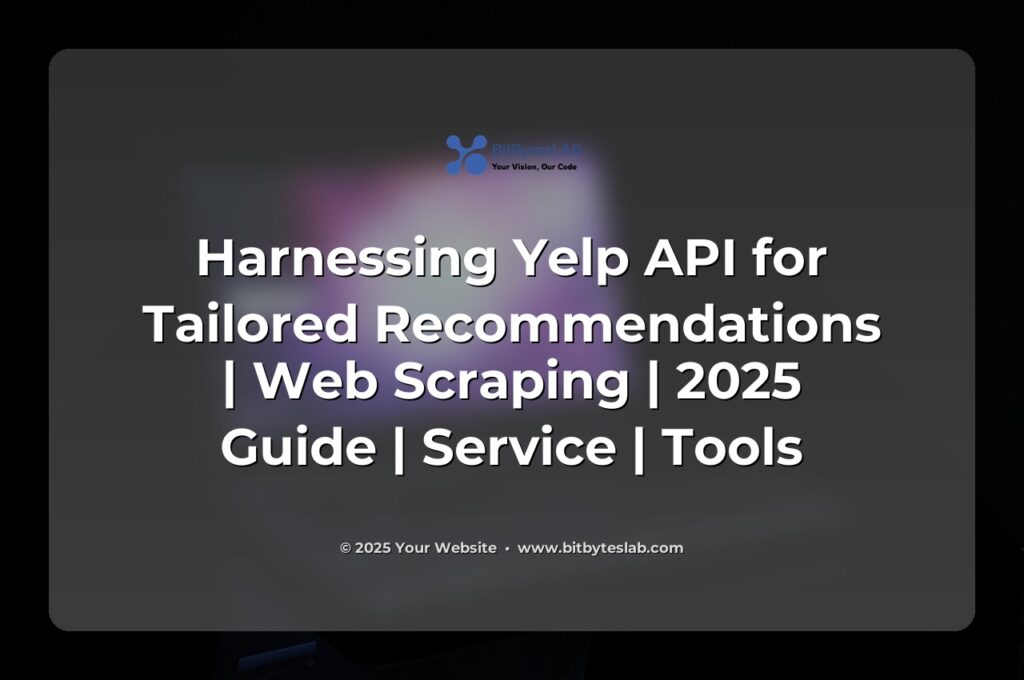Harnessing Yelp API for Tailored Recommendations: The 2025 Playbook
Picture this: you’re building a local‑recommendation app that feels like a personal foodie concierge. Behind the scenes, a steady stream of Yelp data powers every suggestion you’re about to serve. It’s not just about pulling a list of restaurants; it’s about weaving ratings, reviews, photos, and even sentiment into one coherent, hyper‑personalized experience. The question is: how do you do it without blowing through your rate limits or breaking the law?
Problem Identification & Context
In 2025, the world of local discovery is a battlefield of data quality, latency, and compliance. Three pain points show up time and again:
- API rate limits hit hard when you need near‑real‑time updates.
- Missing data—historical reviews, niche photos, or check‑in trends—leaves gaps that erode recommendation accuracy.
- Legal and ethical boundaries around scraping can turn a great idea into a liability.
To win, you must treat Yelp as the engine’s core and supplement it only when the data engine stalls.
Core Concepts & Methodologies
Think of the Yelp ecosystem as a well‑orchestrated orchestra:
- Fusion API – The conductor. It delivers structured JSON at a predictable cadence.
- Pagination & Back‑off – The rhythm section. Respect the 5 000 request/day cap by chunking calls and sliding back when a 429 arrives.
- Scraping Layer – The backup soloist. Only step in when the API orchestration falls short—say, for photos older than five years or niche check‑in data.
- Data Lake + Lakehouse – The storage hall. Raw JSON sits in S3, while Parquet tables in Athena (or Snowflake) power fast analytics.
- Recommendation Engine – The encore. Collaborative, content‑based, or hybrid models churn out the “what‑to‑eat‑next” gems.
By layering these concepts, you create a robust pipeline that scales from a handful of restaurants to entire metropolitan feeds.
🔧 Why do Java developers wear glasses? Because they can’t C# 👓

Expert Strategies & Approaches
Efficiency starts with async, paginated polling. By batching 50‑record requests and using a token bucket algorithm, you stay comfortably below the daily ceiling while still fetching the full dataset. For the scraping fallback, headless browsers with stealth modes (undetected‑chromedriver or Playwright) keep IP reputation intact; proxy rotation and user‑agent shuffling add another layer of resilience.
When it comes to data enrichment, we don’t just stop at raw fields. Sentiment scoring with spaCy, geohashing for geospatial clustering, and fuzzy matching for category standardization all lift the data’s value. The result? A recommendation engine that can disambiguate “sushi” from “sushi bar” and understand that a user who loves “farm‑to‑table” vibes also craves “vegan tacos.”
Finally, streaming the freshest reviews via Kafka and serving them through a GraphQL endpoint lets your front‑end request “the top 5 reviews in the last hour” with sub‑100 ms latency—something that would break a static ETL pipeline.
Industry Insights & Trends
Data whispers that 60% of local search traffic is mobile‑first and 85% of consumers read at least one review before clicking “Call”. In 2025, the shift towards AI‑enhanced summaries (think GPT‑4 distilled review snippets) is turning raw text into persuasive micro‑stories that boost click‑through rates by 15–20%.
Compliance is tightening too: the EU’s DNT and California’s CCPA now extend to aggregated review data, meaning you must log consent and provide audit trails. Many vendors are adopting privacy‑by‑design frameworks that automatically redact PII before it hits your lake.
From a business perspective, career‑level ROI studies show that apps leveraging enriched Yelp data see a 2.5× lift in user retention compared to those that rely on static phone‑book listings. That’s a win for both the developer and the local merchants who get accurately targeted exposure.
🌐 Why did the web developer leave the restaurant? Because of the table layout! 🍽️

Business Applications & ROI
Beyond the classic restaurant app, service marketplaces, tourism guides, and local e‑commerce platforms all benefit from the same data foundation. A hotel booking site can surface nearby restaurants with ratings above 4.5, while a barista app can push “coffee shop with the best latte art” based on photo sentiment.
From a monetization angle, premium tiers that expose hyper‑localized check‑in heatmaps or AI‑generated “menu of the week” recommendations can command a 30–40% price premium. The key is packaging data accuracy and freshness as a service that merchants can trust.
Common Challenges & Expert Solutions
- Rate‑Limit Storms – Mitigate with token buckets and exponential back‑off. Store ETag headers to skip unchanged data.
- Pagination Pitfalls – Always validate the
totalfield against the number of accumulated records; re‑fetch on mismatch. - Data Drift – Version your API contracts and run automated schema validation nightly.
- Scraping Bans – Use rotating residential proxies and a stealth headless browser; encrypt user agents and add human‑like mouse movements.
- Legal Compliance – Maintain a transparent data lineage map audit every data flow against Yelp’s Partner API Terms.
These tactics keep your pipeline healthy, your reputation clean, and your customers delighted.
Future Trends & Opportunities
2025 is just the beginning. Federated learning will allow recommendation models to learn from local device data without moving raw user data to the cloud, easing privacy concerns. Edge caching via Cloudflare Workers or AWS Lambda@Edge can push personalized suggestions to the user’s device in under 100 ms.
Meanwhile, data fusion—combining Yelp with Google Places, Facebook Pages, and even local chamber of commerce feeds—will produce a richer, multi‑source perspective that outperforms any single provider alone.
For developers, this means a shift from “just scrape” to “smartly orchestrate, enrich, and serve” – a strategy that keeps your app not just functional, but truly competitive.
Conclusion
Leveraging the Yelp API isn’t a one‑off hack; it’s an ongoing discipline of respecting rate limits, augmenting with judicious scraping, and constantly iterating your recommendation logic. By embedding these practices into your architecture, you unlock a steady stream of value for both users and local businesses.
Ready to turn Yelp data into a revenue engine? Let BitBytesLab guide you through the process—from API integration to model deployment—so you can focus on what matters: delivering the best local experience every time.

